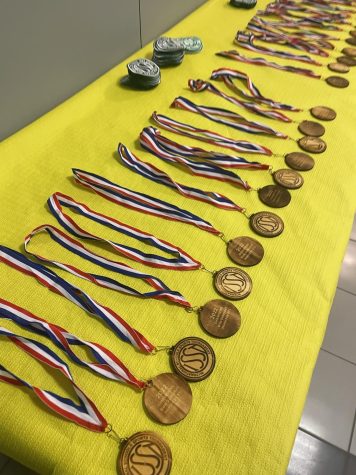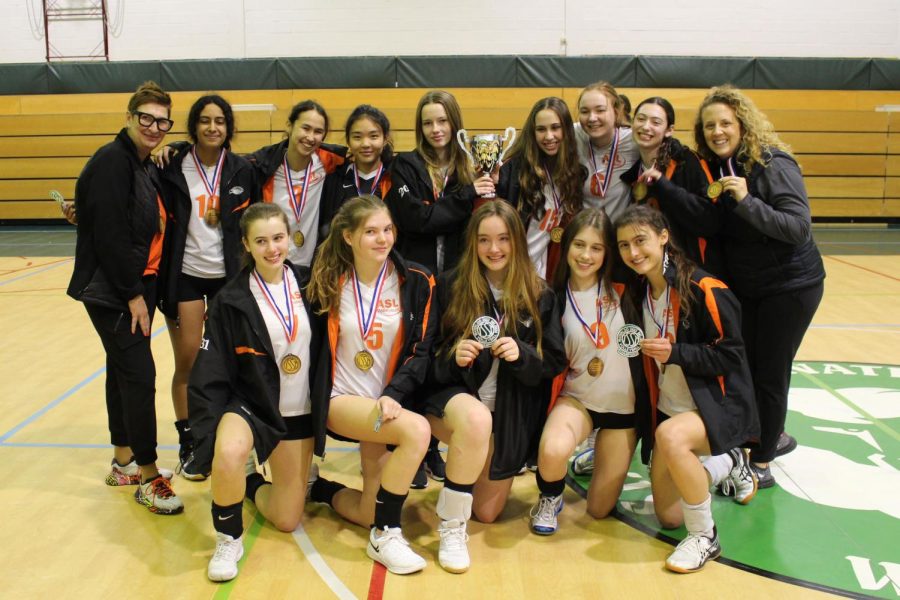Photo courtesy of Elena Alexander
The varsity girls’ volleyball team poses after winning the ISST competition Nov. 12. The team’s victory at the competition was the first since 2015.
Debate rises over ISST medal sustainability
After three years without The International School Sports Tournament due to the pandemic, the competition resumed for fall sports in the spring of 2022. Of the six teams that competed this fall, five teams came first in their respective tournaments.
Traditionally, at the end of each ISST, the winners receive a medal along with an engraved trophy. This year, all winning teams were instead awarded wooden medals and did not receive trophies.
Despite the achievement of the varsity boys’ soccer team winning the competition, Rishi Kurada (’23), a player on the team, said the awards the team received were subpar.
“During the season we were all getting really excited for a big trophy reveal,” Kurada said.
Even though the varsity boys’ soccer team did not initially receive a trophy from competition hosters, the parents of the team bought medals and a trophy for each player. Kurada said the parents’ efforts were appreciated but said he is understanding of the change in awards.
“I wouldn’t say it was disappointing to not see a trophy or get metal medals instead of wood ones,” Kurada said. “All I can say is I do appreciate the new medals.”
Similarly, the girls’ varsity volleyball team won their ISST tournament. Rion Emery (’25), a team member, said the experience was “exciting” and thus, she was unbothered by the wooden medals.
“In the moment, it wasn’t that big of a deal,” Emery said. “It’s also, like, high school competition, so it’s not necessarily the biggest thing in the world.”
However, Emery said using non-wooden medals would have been more “professional.”
“It would have been nice to get a gold medal because that’s more standard,” Emery said.
What do we, as an organization, think about allowing us to continue producing these at the expense of the environment?
— Athletics Director John Farmer
Athletics Director John Farmer said the change in awards was to improve sustainability. With the ISSTs consisting of schools from various countries, Farmer said ASL and other schools have been working on reducing their carbon footprint during the tournament.
“We moved from 23 schools to 13 schools to 10 schools to next year, eight schools,” Farmer said. “There’s a lot of reasons from a logistics standpoint, and from a competition standpoint, but a big part of it too is sustainability and carbon footprint.”
Farmer said some schools were located too far to travel to in a sustainable way, with ACS Athens as an example.
“Athens became a school that had to step away from the ISSTs because it was clear from a sustainability standpoint, that if we go to Athens, all schools would need to fly,” Farmer said.

Farmer said using wooden medals greatly improves the sustainability of the competition.
“There’s a lot of, you know, materials that need to be mined,” Farmer said. “What do we, as an organization, think about allowing us to continue producing these at the expense of the environment?”
Despite moving toward sustainability, Kurada said the change felt a bit excessive.
“If it is for sustainability, I do understand it completely,” Kurada said. “I just think if there’s a long-standing tradition for metal for the first place ISSTs team, should we really go and change that when there could be other changes made in other places?”
Similarly, Emery said she would have preferred sustainability changes in other areas of the organization, such as reducing plastic use.
“They’re definitely stepping in the right direction,” Emery said. “There’s other more important aspects to return to being more sustainable.”
Farmer said he recognizes that some of the athletes do not embrace the wooden medals in the same way that the previous medals were, and thus, has worked on finding another alternative.
“A few other people have said, ‘Yeah, they weren’t very popular in our school either and the students didn’t seem to really like it very much,’” Farmer said. “So, we’re a little bit back to the drawing board in terms of looking at what next steps could be or what materials we might be able to use.”
Despite some pleas to bring back the original medals, Farmer said the school and the ISST organization at large are committed to creating a more sustainable tournament.
“We don’t think we are going to go back to a metal-based medal,” Farmer said. “We really want to put our money where our mouth is and not just talk about wanting to be a more sustainable organization, but make sure that we are doing everything we can to be as good stewards of the environment as we possibly can.”

